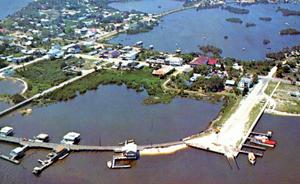|
|
|

|
|
Photo courtesy of Florida Photo Archives.
|
The fishing village of Cedar Key was one of Florida’s busiest ports only a century ago. Founded in 1842 as a resort destination, the town had a deep natural harbor situated between Seahorse, Snake, Atsena-Otie, and Way Keys. Mild weather and excellent fishing and hunting were attractions for wealthy travelers. By the end of the Civil War, the center of population was on Way Key, now called Cedar Key. The port boomed when a railroad was built to link it to the interior. Local cedar trees supplied wood for the foremost pencil factory in the country while the harbor accommodated ships bringing graphite from Siberia for the pencil leads. The seafood harvesting industry brought large profits as well. A Union naval blockade during the Civil War didn't harm the port, but nature did. A ten-foot tidal surge from the 1896 hurricane nearly destroyed the entire town. The port declined in the early 20th century through a combination of a damaging fire, the depletion of cedar trees, and Hurricane Easy in 1950. Today Cedar Key has returned to its origin as a haven for tourists. It celebrates a short but colorful history with visitors who enjoy its small-town atmosphere and unspoiled environment.
|
Find out more:
Steven Rajtar
Dees, Jesse Walter, Jr. and Vivian Flannery Dees. Off the Beaten Path: The History of Cedar Key, Florida, 1843-1990. Rife Publishing, Chiefland, Fla., 1990.
Fishburne, Charles, Jr. The Cedar Keys in the 19th Century. Seahawk Publications, Quincy, Fla., 1983.
Gannon, Michael, editor. The New History of Florida. University Press of Florida, Gainesville, Fla., 1996.
|
|






